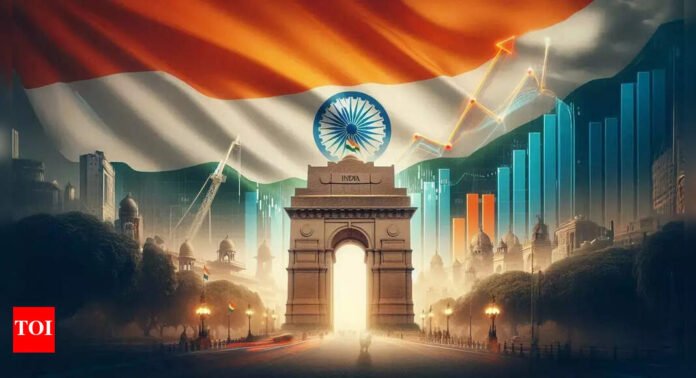How the Iran-Israel Conflict Could Affect India’s Growth

India’s economy may grow by 6.3–6.5% in 2025-26, despite global pressures. (AI image)
India is the world’s fastest-growing major economy. Demand is rising, and inflation is at a 6-year low. The RBI has cut the repo rate by 1%. This lowers borrowing costs for businesses. It boosts demand, improves capacity use, and may increase private investment.
Threats to Economic Strength
However, this economic strength faces threats. Trade tensions and rising crude oil prices due to the Iran-Israel conflict could spiral out of control. Escalating tensions in West Asia pose a significant risk. A major conflict could spike oil prices, trigger inflation, and weaken demand. This threatens growth.
Oil Price Scenarios
Oil prices could range from $65 to over $120 per barrel. This depends on the conflict’s severity. For Indian businesses, surging oil prices would increase production costs. They would also reduce consumer spending and disrupt exports. This is especially true if Red Sea routes are compromised. Ships would have to take longer and costlier routes.
DK Srivastava, Chief Policy Advisor at EY India, tells TOI, “The global economy is facing tough times. Conflicts like Russia-Ukraine and Israel-Hamas are ongoing. The Israel-Hamas conflict risks turning into a wider Israel-Iran war. Additionally, the US has hinted at raising tariffs. This adds more uncertainty. These global issues are slowing down the world economy. The World Bank has lowered its global growth forecast for 2025-26 to just 2.3%, down from 2.7%.”
“India could feel the impact of these global developments through net exports. They have been negative in recent years. From 2022-23 to 2024-25, net exports marginally pulled down our real GDP growth. If trade-related tensions continue, this could worsen,” he says.
Oil Price Spike & India’s Energy Security
JP Morgan has warned that oil prices could rise to $120 per barrel. This could happen if the Middle East situation deteriorates. According to the bank’s analysis, current prices already include a 7% probability of a severe geopolitical scenario. This scenario could lead to significant disruption in Iranian oil production. It would cause a dramatic increase in prices.
However, despite ongoing regional tensions, JP Morgan maintains a conservative outlook. It keeps its primary forecast for Brent crude in the lower to middle $60s range through 2025. This is followed by $60 in 2026. The bank’s projection assumes that regional authorities will take necessary steps to avoid an all-encompassing conflict.
The cost of benchmark US oil per barrel declined by 3.3% to $70.59 on Monday. This reflects optimism that the conflict might stay limited in scope. This followed Friday’s surge of slightly above 7% after the initial strikes. The downward price movement gained momentum after reports that Iran had indicated its desire to cease hostilities and return to nuclear program discussions.
DK Srivastava notes that crude oil is cheaper now. It averages $64.3 per barrel during April-May 2025-26. This is down from a high of $85.3 per barrel in Q2 of 2023-24. But if tensions in the Middle East grow, crude prices could rise again. This would hurt both growth and inflation in India.
“A past RBI study showed that a $10 per barrel rise in the price of India’s crude basket could reduce India’s real GDP growth by 0.3% points. It could also increase its CPI inflation by 0.4% points,” he adds.
According to the Global Trade Research Initiative (GTRI), India needs to assess energy security risks. It should expand its crude oil sources and maintain adequate strategic petroleum reserves. GTRI believes that the escalating situation in West Asia poses significant risks to India’s energy security, maritime trade routes, and business relationships.
The nation’s heavy reliance on the Strait of Hormuz for importing approximately two-thirds of its crude oil and half of its LNG has become critical due to Iranian threats. This crucial maritime passage, spanning merely 21 miles at its narrowest point, facilitates roughly one-fifth of the world’s oil trade.
With India’s dependence on foreign sources exceeding 80% of its energy requirements, any interference in this route would trigger increased oil prices, elevated shipping expenses, and higher insurance costs. According to GTRI, these disruptions could potentially drive up inflation rates, cause rupee depreciation, and pose significant obstacles to governmental fiscal planning.
However, Oil Minister Hardeep Singh Puri has said that India, being the third-largest oil importer and fourth-largest gas purchaser globally, maintains sufficient energy reserves for the coming months.
“India’s energy strategy is shaped by successfully navigating the trilemma of energy availability, affordability, and sustainability,” he said. “We have adequate energy supplies for the coming months.”
Adverse Impact on Trade
India maintains substantial trade relationships with both Israel and Iran. During FY2025, India’s exports to Iran reached $1.24 billion, while imports stood at $441.9 million. The trade volume with Israel is higher, with $2.15 billion in exports and $1.61 billion in imports.
The ongoing conflict is expected to have adverse effects on trade. While there were signs of recovery, trade activities will now face renewed disruptions. According to Federation of Indian Export Organisations (FIEO) President S C Ralhan, exports to European nations and Russia could be affected. Freight charges and insurance costs are expected to increase.
Although Indian export shipments had resumed their transit through the Red Sea corridor, these operations are likely to face fresh disruptions, as noted by Ralhan.
The immediate consequences of the conflict include elevated freight and insurance rates. This follows a period of stability when Red Sea routes were returning to regular operations, according to Mumbai-based exporter and Technocraft Industries Ltd Founder Chairman S K Saraf.
GTRI says that approximately 30% of India’s exports heading west towards Europe, North Africa, and America’s Eastern seaboard use the Bab el-Mandeb Strait. The current situation poses risks to this vital maritime route. Should vessels need to navigate around the Cape of Good Hope, journey durations would increase by a fortnight. This would cause substantial hikes in shipping expenses.
Such disruptions would impact Indian export sectors, including engineering products, textile goods, and chemical shipments. They would also increase import expenditure.
Should India Be Worried?
Government officials are planning to conduct discussions with export sector representatives in the upcoming days to address recent developments. The current tensions between Israel and Iran are not expected to significantly affect India’s economy unless the situation expands into a wider and sustained regional conflict, according to a senior official who said that authorities are monitoring developments closely.
The situation could lead to temporary fluctuations in international oil prices, affect capital movements, cause currency variations, and increase shipping expenses in the near term, the official acknowledged.
The official told ET that while it remains premature to determine the exact consequences for India, the finance ministry and regulatory bodies will maintain enhanced surveillance due to market instability. India’s robust macroeconomic indicators position it well to weather any such international crisis with minimal adverse effects, the official stated.
The official also indicated that the situation is unlikely to cause any significant or lasting effect on global non-energy commodity prices in the medium-term perspective.
EY’s DK Srivastava also strikes an optimistic note about India’s strong economic fundamentals. “On the positive side, India’s central bank has started cutting the policy interest rate. It has been reduced by 1% points since January 2025, to 5.5% in June 2025. This should continue, ideally bringing the rate to 5% or below.”
“The government is also spending more on infrastructure. Capital spending grew strongly in March and April 2025. These two steps—lower interest rates and larger public investment—should help mitigate the negative effects of global challenges. We expect India’s economy to grow by 6.3–6.5% in 2025-26, despite these global pressures,” he concludes.



